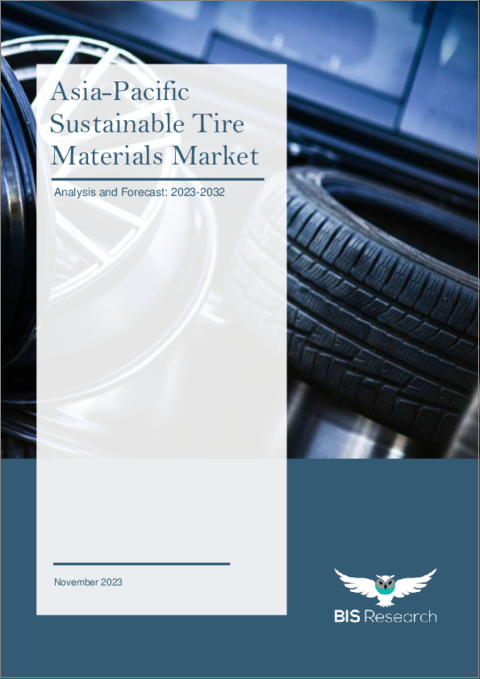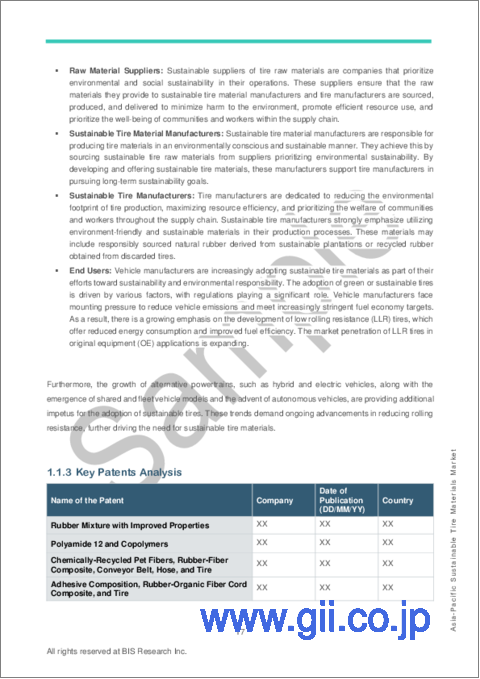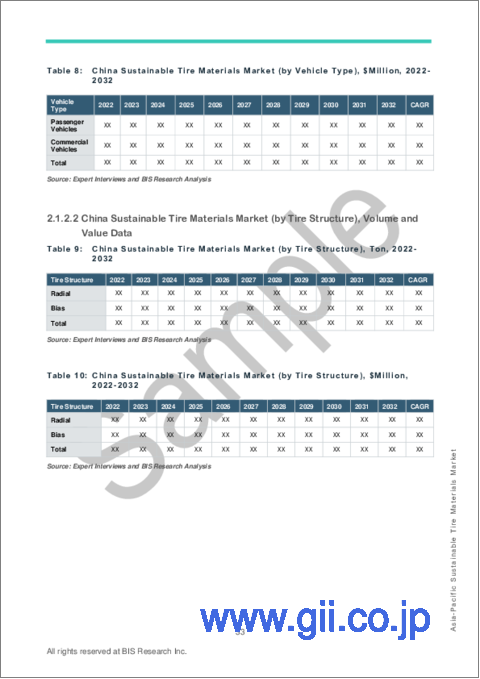|
|
市場調査レポート
商品コード
1389584
アジア太平洋地域のサステイナブルタイヤ素材市場の分析・予測:2023-2032年Asia-Pacific Sustainable Tire Materials Market - Analysis and Forecast, 2023-2032 |
||||||
カスタマイズ可能
|
|||||||
| アジア太平洋地域のサステイナブルタイヤ素材市場の分析・予測:2023-2032年 |
|
出版日: 2023年12月01日
発行: BIS Research
ページ情報: 英文 102 Pages
納期: 1~5営業日
|
全表示
- 概要
- 図表
- 目次
中国を除くアジア太平洋地域のサステイナブルタイヤ素材の市場規模は、2022年の100万米ドルから、予測期間中は19.08%のCAGRで推移し、2032年には510万米ドルの規模に成長すると予測されています。
環境に優しいタイヤへの需要の高まり、新興国市場の開発、自動車・トラック用タイヤの製造工程におけるサステイナブルタイヤ素材の採用などにより、サステイナブルタイヤ素材の市場は成長すると予測されています。
有害な炭素排出と環境への悪影響は、タイヤ製造における再生不可能な資源の使用に関連しています。アジア太平洋地域の主要タイヤメーカーは、この問題に対処するため、燃費の改善、寿命の短縮、カーボンフットプリントの低減を実現した持続可能なタイヤの製造に取り組んでいます。この地域の主要国は、環境への影響を軽減するために高い目標を掲げており、これらの持続可能なタイヤ素材はその目標に合致しています。また、持続可能なタイヤ素材の分野におけるR&Dに重点が置かれるようになった結果、新しく独創的な持続可能なタイヤソリューションが登場することも予想されます。環境に優しいタイヤ素材の市場はまだ初期段階にありますが、予測期間中には大幅に拡大すると予想されています。
当レポートでは、アジア太平洋地域のサステイナブルタイヤ素材の市場を調査し、市場の背景・概要、特許動向、法規制環境、市場成長への各種影響因子の分析、市場規模の推移・予測、各種区分・主要国別の詳細分析、競合情勢、主要企業の分析などをまとめています。
| 主要市場統計 | |
|---|---|
| 予測期間 | 2023-2032年 |
| 2023年評価 | 100万米ドル |
| 2032年予測 | 510万米ドル |
| CAGR | 19.08% |
市場の分類
セグメンテーション1:素材タイプ別
- ゴム
- 天然
- リサイクル
- サステイナブルカーボンブラック
- シリカ
- その他
セグメンテーション2:推進タイプ別
- 内燃エンジン車
- 電気自動車
セグメンテーション3:自動車タイプ別
- 乗用車
- 商用車
セグメンテーション4:タイヤ構造別
- ラジアル
- バイアス
セグメンテーション5:販売チャネル別
- OEM
- アフターマーケット
セグメンテーション6:地域別
- アジア太平洋および日本:日本、韓国、インド、その他
主要企業:
- LDC-KOREA CO., LTD.
- GRP LTD.
- SNR Reclamations Pvt. Ltd.
- Bridgestone Corporation
目次
第1章 市場
- 業界の展望
- 業界の動向
- サプライチェーンネットワーク
- 主要特許分析
- タイヤリサイクルの概要
- タイヤ素材市場に関する規制
- 事業力学
- 事業促進要因
- 事業上の課題
- 事業戦略
- 企業戦略
- 事業機会
第2章 地域
- 中国
- 市場
- 用途
- 製品
- アジア太平洋および日本
- 市場
- 用途
- 製品
- 国レベルの分析
第3章 市場:競合ベンチマーキング・企業プロファイル
- 競合ベンチマーキング
- 持続可能タイヤ素材メーカーの競合マトリックス
- タイヤメーカーの市場シェア分析
- 企業プロファイル
- タイプ1企業:持続可能タイヤ素材製造業者
第4章 調査手法
List of Figures
- Figure 1: Sustainable Tire Materials Market Overview, $Million, 2022-2032
- Figure 2: Sustainable Tire Materials Market (by Propulsion Type), $Million, 2022-2032
- Figure 3: Sustainable Tire Materials Market (by Vehicle Type), $Million, 2022-2032
- Figure 4: Sustainable Tire Materials Market (by Tire Structure), $Million, 2022-2032
- Figure 5: Sustainable Tire Materials Market (by Sales Channel), $Million, 2022-2032
- Figure 6: Sustainable Tire Materials Market (by Type of Material), $Million, 2022-2032
- Figure 7: Sustainable Tire Materials Market (by Region), $Million, 2022
- Figure 8: Sustainable Tire Materials Market Supply Chain
- Figure 9: Sustainable Tire Materials Market Supply Chain Participants
- Figure 10: Tire Wear: Tire Characteristic Approach by Vehicle Type (Combustion Vehicles vs. Electric Vehicles)
- Figure 11: Key Business Strategies
- Figure 12: Product Developments (by Company), 2019-2023
- Figure 13: Key Corporate Strategies
- Figure 14: Mergers, Acquisitions, and Divestments
- Figure 15: Partnerships, Joint Ventures, Collaborations, and Alliances
- Figure 16: Tire Circular Economy Model
- Figure 17: Competitive Benchmarking for Sustainable Tire Materials Manufacturers in China
- Figure 18: Competitive Benchmarking for Sustainable Tire Materials Manufacturers in Asia-Pacific and Japan
- Figure 19: Competitive Benchmarking
- Figure 20: Bridgestone Corporation: R&D Expenditure, $Million, 2020 -2022
- Figure 21: Data Triangulation
- Figure 22: Top-Down and Bottom-Up Approach
List of Tables
- Table 1: Sustainable Tire Materials Market Overview
- Table 2: Key Companies Profiled
- Table 3: Sustainable Tire Materials Market: Business Drivers
- Table 4: Impact of Business Restraints
- Table 5: Impact of Business Opportunities
- Table 6: Sustainable Tire Materials Market (by Region), Ton, 2022-2032
- Table 7: Sustainable Tire Materials Market (by Region), $Million, 2022-2032
- Table 8: China Sustainable Tire Materials Market (by Vehicle Type), Ton, 2022-2032
- Table 9: China Sustainable Tire Materials Market (by Vehicle Type), $Million, 2022-2032
- Table 10: China Sustainable Tire Materials Market (by Tire Structure), Ton, 2022-2032
- Table 11: China Sustainable Tire Materials Market (by Tire Structure), $Million, 2022-2032
- Table 12: China Sustainable Tire Materials Market (by Propulsion Type), Ton, 2022-2032
- Table 13: China Sustainable Tire Materials Market (by Propulsion Type), $Million, 2022-2032
- Table 14: China Sustainable Tire Materials Market (by Sales Channel), Ton, 2022-2032
- Table 15: China Sustainable Tire Materials Market (by Sales Channel), $Million, 2022-2032
- Table 16: China Sustainable Tire Materials Market (by Type of Material), Ton, 2022-2032
- Table 17: China Sustainable Tire Materials Market (by Type of Material), $Million, 2022-2032
- Table 18: Asia-Pacific and Japan Sustainable Tire Materials Market (by Vehicle Type), Ton, 2022-2032
- Table 19: Asia-Pacific and Japan Sustainable Tire Materials Market (by Vehicle Type), $Million, 2022-2032
- Table 20: Asia-Pacific and Japan Sustainable Tire Materials Market (by Tire Structure), Ton, 2022-2032
- Table 21: Asia-Pacific and Japan Sustainable Tire Materials Market (by Tire Structure), $Million, 2022-2032
- Table 22: Asia-Pacific and Japan Sustainable Tire Materials Market (by Propulsion Type), Ton, 2022-2032
- Table 23: Asia-Pacific and Japan Sustainable Tire Materials Market (by Propulsion Type), $Million, 2022-2032
- Table 24: Asia-Pacific and Japan Sustainable Tire Materials Market (by Sales Channel), Ton, 2022-2032
- Table 25: Asia-Pacific and Japan Sustainable Tire Materials Market (by Sales Channel), $Million, 2022-2032
- Table 26: Asia-Pacific and Japan Sustainable Tire Materials Market (by Type of Material), Ton, 2022-2032
- Table 27: Asia-Pacific and Japan Sustainable Tire Materials Market (by Type of Material), $Million, 2022-2032
- Table 28: Japan Sustainable Tire Materials Market (by Vehicle Type), Ton, 2022-2032
- Table 29: Japan Sustainable Tire Materials Market (by Vehicle Type), $Thousand, 2022-2032
- Table 30: Japan Sustainable Tire Materials Market (by Tire Structure), Ton, 2022-2032
- Table 31: Japan Sustainable Tire Materials Market (by Tire Structure), $Thousand, 2022-2032
- Table 32: Japan Sustainable Tire Materials Market (by Propulsion Type), Ton, 2022-2032
- Table 33: Japan Sustainable Tire Materials Market (by Propulsion Type), $Thousand, 2022-2032
- Table 34: Japan Sustainable Tire Materials Market (by Type of Material), Ton, 2022-2032
- Table 35: Japan Sustainable Tire Materials Market (by Type of Material), $Thousand, 2022-2032
- Table 36: South Korea Sustainable Tire Materials Market (by Vehicle Type), Ton, 2022-2032
- Table 37: South Korea Sustainable Tire Materials Market (by Vehicle Type), $Thousand, 2022-2032
- Table 38: South Korea Sustainable Tire Materials Market (by Tire Structure), Ton, 2022-2032
- Table 39: South Korea Sustainable Tire Materials Market (by Tire Structure), $Thousand, 2022-2032
- Table 40: South Korea Sustainable Tire Materials Market (by Propulsion Type), Ton, 2022-2032
- Table 41: South Korea Sustainable Tire Materials Market (by Propulsion Type), $Thousand, 2022-2032
- Table 42: South Korea Sustainable Tire Materials Market (by Type of Material), Ton, 2022-2032
- Table 43: South Korea Sustainable Tire Materials Market (by Type of Material), $Thousand, 2022-2032
- Table 44: India Sustainable Tire Materials Market (by Vehicle Type), Ton, 2022-2032
- Table 45: India Sustainable Tire Materials Market (by Vehicle Type), $Thousand, 2022-2032
- Table 46: India Sustainable Tire Materials Market (by Tire Structure), Ton, 2022-2032
- Table 47: India Sustainable Tire Materials Market (by Tire Structure), $Thousand, 2022-2032
- Table 48: India Sustainable Tire Materials Market (by Propulsion Type), Ton, 2022-2032
- Table 49: India Sustainable Tire Materials Market (by Propulsion Type), $Thousand, 2022-2032
- Table 50: India Sustainable Tire Materials Market (by Type of Material), Ton, 2022-2032
- Table 51: India Sustainable Tire Materials Market (by Type of Material), $Thousand, 2022-2032
- Table 52: Rest-of-Asia-Pacific and Japan Sustainable Tire Materials Market (by Vehicle Type), Ton, 2022-2032
- Table 53: Rest-of-Asia-Pacific and Japan Sustainable Tire Materials Market (by Vehicle Type), $Thousand, 2022-2032
- Table 54: Rest-of-Asia-Pacific and Japan Sustainable Tire Materials Market (by Tire Structure), Ton, 2022-2032
- Table 55: Rest-of-Asia-Pacific and Japan Sustainable Tire Materials Market (by Tire Structure), $Thousand, 2022-2032
- Table 56: Rest-of-Asia-Pacific and Japan Sustainable Tire Materials Market (by Propulsion Type), Ton, 2022-2032
- Table 57: Rest-of-Asia-Pacific and Japan Sustainable Tire Materials Market (by Propulsion Type), $Thousand, 2022-2032
- Table 58: Rest-of-Asia-Pacific and Japan Sustainable Tire Materials Market (by Type of Material), Ton, 2022-2032
- Table 59: Rest-of-Asia-Pacific and Japan Sustainable Tire Materials Market (by Type of Material), $Thousand, 2022-2032
- Table 60: Sustainable Tire Materials Market: Market Share Analysis by Tire Manufacturers, 2022
- Table 61: LDC-KOREA CO., LTD.: Product Portfolio
- Table 62: GRP LTD.: Product Portfolio
- Table 63: SNR Reclamations Pvt. Ltd.: Product Portfolio
- Table 64: Bridgestone Corporation: Product Portfolio
“The Asia-Pacific Sustainable Tire Materials Market (excluding China) Expected to Reach $5.1 Million by 2032.”
Introduction to Asia-Pacific Sustainable Tire Materials Market
The Asia-Pacific sustainable tire materials market (excluding China) is projected to reach $5.1 million by 2032 from $1.0 million in 2022, growing at a CAGR of 19.08% during the forecast period 2023-2032. The market for sustainable tire materials is anticipated to rise as a result of the increasing demand for environmentally friendly tires, new developments, and the incorporation of sustainable tire materials during the production process of tires for cars and trucks.
Market Introduction
| KEY MARKET STATISTICS | |
|---|---|
| Forecast Period | 2023 - 2032 |
| 2023 Evaluation | $1.0 Million |
| 2032 Forecast | $5.1 Million |
| CAGR | 19.08% |
Harmful carbon emissions and detrimental effects on the environment are linked to the use of non-renewable resources in tire production. Leading APAC tire producers, including Michelin and The Goodyear Tire and Rubber Company, are now making sustainable tires with improved fuel efficiency, a shorter lifespan, and a lower carbon footprint in order to address this problem. The region's leading nations have set high goals to lessen their influence on the environment, and these sustainable tire materials meet those goals. It is also anticipated that new and creative sustainable tire solutions will be introduced as a result of the increased focus on research and development in the area of sustainable tire materials. While the market for environmentally friendly tire materials is still in its infancy, it is expected to increase significantly in the forecasted period.
Market Segmentation:
Segmentation 1: by Type of Material
- Rubber
- Natural
- Recycled
- Sustainable Carbon Black
- Silica
- Others
Segmentation 2: by Propulsion Type
- Internal Combustion Engine Vehicles
- Electric Vehicles
Segmentation 3: by Vehicle Type
- Passenger Vehicles
- Commercial Vehicles
Segmentation 4: by Tire Structure
- Radial
- Bias
Segmentation 5: by Sales Channel
- OEMs
- Aftermarket
Segmentation 6: by Region
- Asia-Pacific and Japan: Japan, South Korea, India, and Rest-of-Asia-Pacific and Japan
How can this report add value to an organization?
Product/Innovation Strategy: In Asia-Pacific, the leading sustainable tire materials manufacturers are continuously working to develop new and innovative sustainable tire materials. The growing need for efficient, eco-friendly, and high-performing tires is one of the major factors for the growth of the sustainable tire materials market. The market is more on the consolidated side at present, where sustainable tire material manufacturers have been successful to a certain extent in strengthening their market position in the global market, with a few sustainable tire material manufacturers developing recovered carbon black, recycled rubber, and sustainable silica for sustainable tires. However, the competition in the market is expected to become intense as the demand for sustainable tire material increases from tire manufacturers to achieve sustainability targets. Moreover, partnerships and collaborations are expected to play a crucial role in strengthening market position over the coming years, with the companies focusing on bolstering their technological capabilities and gaining a dominant market share in the sustainable tire material industry.
Growth/Marketing Strategy: The sustainable tire materials market has been growing at a rapid pace. The market offers enormous opportunities for existing and emerging market players. Some of the strategies covered in this segment are mergers and acquisitions, product launches, partnerships and collaborations, business expansions, and investments. The strategies preferred by companies to maintain and strengthen their market position primarily include partnerships, agreements, and collaborations.
Competitive Strategy: The key players in the sustainable tire materials market analyzed and profiled in the study include multiple sustainable tire material manufacturers and tire manufacturers. Moreover, a detailed competitive benchmarking of the players operating in the sustainable tire materials market has been done to help the reader understand the ways in which players stack against each other, presenting a clear market landscape. Additionally, comprehensive competitive strategies such as partnerships, agreements, and collaborations are expected to aid the reader in understanding the untapped revenue pockets in the market.
Key Market Players and Competition Synopsis
The companies that are profiled have been selected based on inputs gathered from primary experts and analysing company coverage, product portfolio, and market penetration.
Some of the prominent names established in this market are:
|
|
Table of Contents
1 Markets
- 1.1 Industry Outlook
- 1.1.1 Industry Trends
- 1.1.1.1 Change in Business Models of Companies Due to Climate Action
- 1.1.1.2 Increasing Allocation of Funds Toward Environment-Friendly Tire Material Technologies
- 1.1.2 Supply Chain Network
- 1.1.3 Key Patents Analysis
- 1.1.4 Overview of Tire Recycling
- 1.1.5 Regulations on Tire Materials Market
- 1.1.1 Industry Trends
- 1.2 Business Dynamics
- 1.2.1 Business Drivers
- 1.2.1.1 Stringent Regulations and Carbon Neutrality Targets
- 1.2.1.2 Augmented Demand for Sustainable Tire Materials from Transportation and Logistics
- 1.2.1.3 Extended Lifespan and Cost Efficiency of Tires
- 1.2.2 Business Challenges
- 1.2.2.1 Volatility of Tire Prices Made from Sustainable Tire Materials
- 1.2.2.2 Lower Adoption Rate of Sustainable Tire Materials in ICE Vehicles Compared to Electric Vehicles
- 1.2.3 Business Strategies
- 1.2.3.1 Product Developments
- 1.2.3.2 Market Developments
- 1.2.4 Corporate Strategies
- 1.2.4.1 Mergers, Acquisitions, and Divestments
- 1.2.4.2 Partnerships, Joint Ventures, Collaborations, and Alliances
- 1.2.5 Business Opportunities
- 1.2.5.1 Growing Demand for New Sustainable Tire Materials
- 1.2.5.2 Utilization of Advanced Recycling Techniques within the Tire Circular Economy Model
- 1.2.1 Business Drivers
2 Regions
- 2.1 China
- 2.1.1 Market
- 2.1.1.1 Buyer Attributes
- 2.1.1.2 Key Manufacturers in China
- 2.1.1.3 Competitive Benchmarking
- 2.1.1.4 Business Challenges
- 2.1.1.5 Business Drivers
- 2.1.2 Application
- 2.1.2.1 China Sustainable Tire Materials Market (by Vehicle Type), Volume and Value Data
- 2.1.2.2 China Sustainable Tire Materials Market (by Tire Structure), Volume and Value Data
- 2.1.2.3 China Sustainable Tire Materials Market (by Propulsion Type), Volume and Value Data
- 2.1.2.4 China Sustainable Tire Materials Market (by Sales Channel), Volume and Value Data
- 2.1.3 Product
- 2.1.3.1 China Sustainable Tire Materials Market (by Type of Material), Volume and Value Data
- 2.1.1 Market
- 2.2 Asia-Pacific and Japan
- 2.2.1 Market
- 2.2.1.1 Buyer Attributes
- 2.2.1.2 Key Manufacturers in Asia-Pacific and Japan
- 2.2.1.3 Competitive Benchmarking
- 2.2.1.4 Business Challenges
- 2.2.1.5 Business Drivers
- 2.2.2 Application
- 2.2.2.1 Asia-Pacific and Japan Sustainable Tire Materials Market (by Vehicle Type), Volume and Value Data
- 2.2.2.2 Asia-Pacific and Japan Sustainable Tire Materials Market (by Tire Structure), Volume and Value Data
- 2.2.2.3 Asia-Pacific and Japan Sustainable Tire Materials Market (by Propulsion Type), Volume and Value Data
- 2.2.2.4 Asia-Pacific and Japan Sustainable Tire Materials Market (by Sales Channel), Volume and Value Data
- 2.2.3 Product
- 2.2.3.1 Asia-Pacific and Japan Sustainable Tire Materials Market (by Type of Material), Volume and Value Data
- 2.2.4 Asia-Pacific and Japan: Country-Level Analysis
- 2.2.4.1 Japan
- 2.2.4.1.1 Buyer Attributes
- 2.2.4.1.1.1 Key Manufacturers in Japan
- 2.2.4.1.1.2 Business Challenges
- 2.2.4.1.1.3 Business Drivers
- 2.2.4.1.2 Application
- 2.2.4.1.2.1 Japan Sustainable Tire Materials Market (by Vehicle Type), Volume and Value Data
- 2.2.4.1.2.2 Japan Sustainable Tire Materials Market (by Tire Structure), Volume and Value Data
- 2.2.4.1.2.3 Japan Sustainable Tire Materials Market (by Propulsion Type), Volume and Value Data
- 2.2.4.1.3 Product
- 2.2.4.1.3.1 Japan Sustainable Tire Materials Market (by Type of Material), Volume and Value Data
- 2.2.4.1.1 Buyer Attributes
- 2.2.4.2 South Korea
- 2.2.4.2.1 Market
- 2.2.4.2.1.1 Buyer Attributes
- 2.2.4.2.1.2 Key Manufacturers in South Korea
- 2.2.4.2.1.3 Business Challenges
- 2.2.4.2.1.4 Business Drivers
- 2.2.4.2.2 Application
- 2.2.4.2.2.1 South Korea Sustainable Tire Materials Market (by Vehicle Type), Volume and Value Data
- 2.2.4.2.2.2 South Korea Sustainable Tire Materials Market (by Tire Structure), Volume and Value Data
- 2.2.4.2.2.3 South Korea Sustainable Tire Materials Market (by Propulsion Type), Volume and Value Data
- 2.2.4.2.3 Product
- 2.2.4.2.3.1 South Korea Sustainable Tire Materials Market (by Type of Material), Volume and Value Data
- 2.2.4.2.1 Market
- 2.2.4.3 India
- 2.2.4.3.1 Market
- 2.2.4.3.1.1 Buyer Attributes
- 2.2.4.3.1.2 Key Manufacturers in India
- 2.2.4.3.1.3 Business Challenges
- 2.2.4.3.1.4 Business Drivers
- 2.2.4.3.2 Application
- 2.2.4.3.2.1 India Sustainable Tire Materials Market (by Vehicle Type), Volume and Value Data
- 2.2.4.3.2.2 India Sustainable Tire Materials Market (by Tire Structure), Volume and Value Data
- 2.2.4.3.2.3 India Sustainable Tire Materials Market (by Propulsion Type), Volume and Value Data
- 2.2.4.3.3 Product
- 2.2.4.3.3.1 India Sustainable Tire Materials Market (by Type of Material), Volume and Value Data
- 2.2.4.3.1 Market
- 2.2.4.4 Rest-of-Asia-Pacific and Japan
- 2.2.4.4.1 Market
- 2.2.4.4.1.1 Buyer Attributes
- 2.2.4.4.1.2 Key Manufacturers in Rest-of-Asia-Pacific and Japan
- 2.2.4.4.1.3 Business Challenges
- 2.2.4.4.1.4 Business Drivers
- 2.2.4.4.2 Application
- 2.2.4.4.2.1 Rest-of-Asia-Pacific and Japan Sustainable Tire Materials Market (by Vehicle Type), Volume and Value Data
- 2.2.4.4.2.2 Rest-of-Asia-Pacific and Japan Sustainable Tire Materials Market (by Tire Structure), Volume and Value Data
- 2.2.4.4.2.3 Rest-of-Asia-Pacific and Japan Sustainable Tire Materials Market (by Propulsion Type), Volume and Value Data
- 2.2.4.4.3 Product
- 2.2.4.4.3.1 Rest-of-Asia-Pacific and Japan Sustainable Tire Materials Market (by Type of Material), Volume and Value Data
- 2.2.4.4.1 Market
- 2.2.4.1 Japan
- 2.2.1 Market
3 Markets - Competitive Benchmarking & Company Profiles
- 3.1 Competitive Benchmarking
- 3.1.1 Competitive Position Matrix for Sustainable Tire Materials Manufacturers
- 3.2 Market Share Analysis for Tire Manufacturers
- 3.3 Company Profiles
- 3.3.1 Type 1 Companies: Sustainable Tire Material Manufacturers
- 3.3.1.1 LDC-KOREA CO., LTD.
- 3.3.1.1.1 Company Overview
- 3.3.1.1.2 Role of LDC-KOREA CO., LTD. in the Sustainable Tire Materials Market
- 3.3.1.1.2.1 Product Portfolio
- 3.3.1.1.3 Analyst View
- 3.3.1.2 GRP LTD.
- 3.3.1.2.1 Company Overview
- 3.3.1.2.2 Role of GRP LTD. in the Sustainable Tire Materials Market
- 3.3.1.2.2.1 Product Portfolio
- 3.3.1.2.3 Analyst View
- 3.3.1.3 SNR Reclamations Pvt. Ltd.
- 3.3.1.3.1 Company Overview
- 3.3.1.3.2 Role of SNR Reclamations Pvt. Ltd. in the Sustainable Tire Materials Market
- 3.3.1.3.2.1 Product Portfolio
- 3.3.1.3.3 Analyst View
- 3.3.1.4 Bridgestone Corporation
- 3.3.1.4.1 Company Overview
- 3.3.1.4.2 Role of Bridgestone Corporation in the Sustainable Tire Materials Market
- 3.3.1.4.2.1 Product Portfolio
- 3.3.1.4.3 Business Strategies
- 3.3.1.4.3.1 Product Developments
- 3.3.1.4.4 R&D Analysis
- 3.3.1.4.5 Analyst View
- 3.3.1.1 LDC-KOREA CO., LTD.
- 3.3.1 Type 1 Companies: Sustainable Tire Material Manufacturers
4 Research Methodology
- 4.1 Data Sources
- 4.1.1 Primary Data Sources
- 4.1.2 Secondary Data Sources
- 4.1.3 Data Triangulation
- 4.2 Market Estimation and Forecast
- 4.2.1 Research Methodology - Bottom - Up Approach
- 4.2.2 Factors for Data Prediction and Modeling






